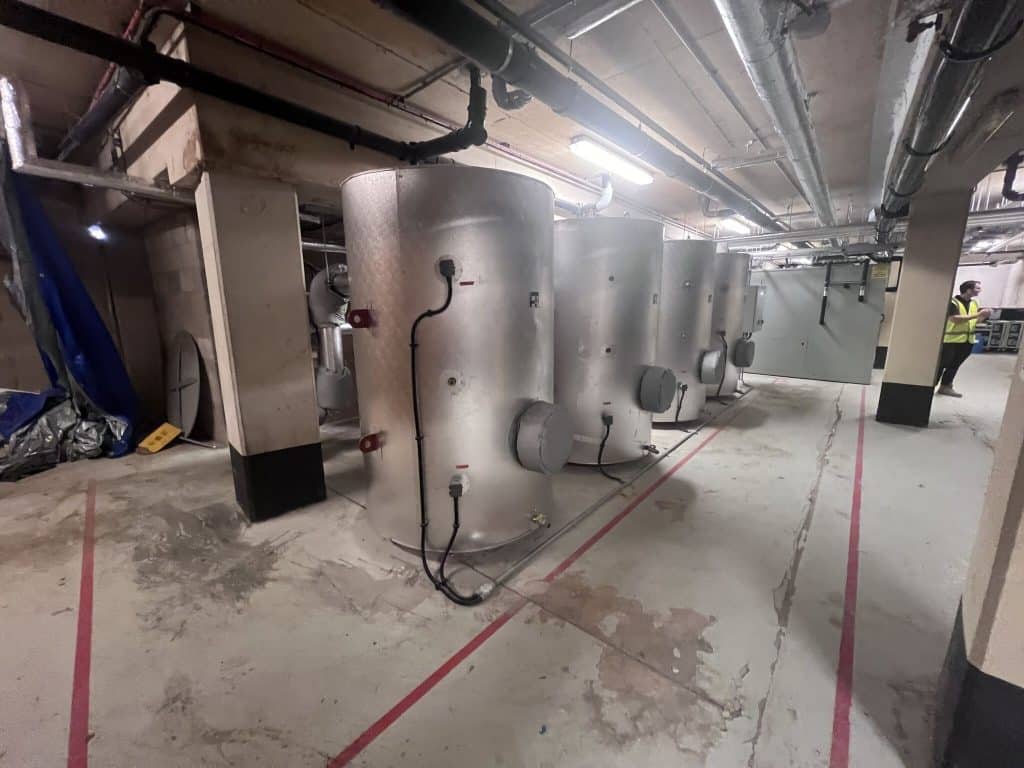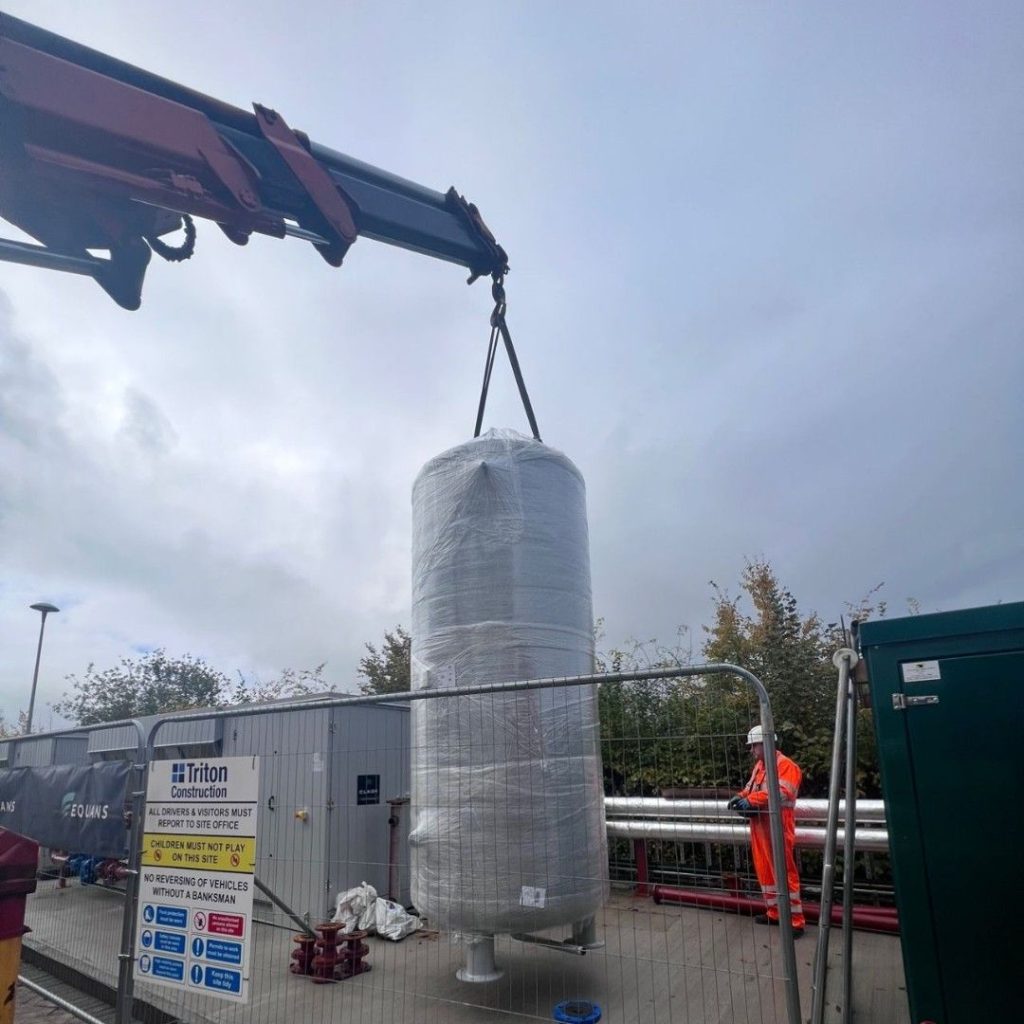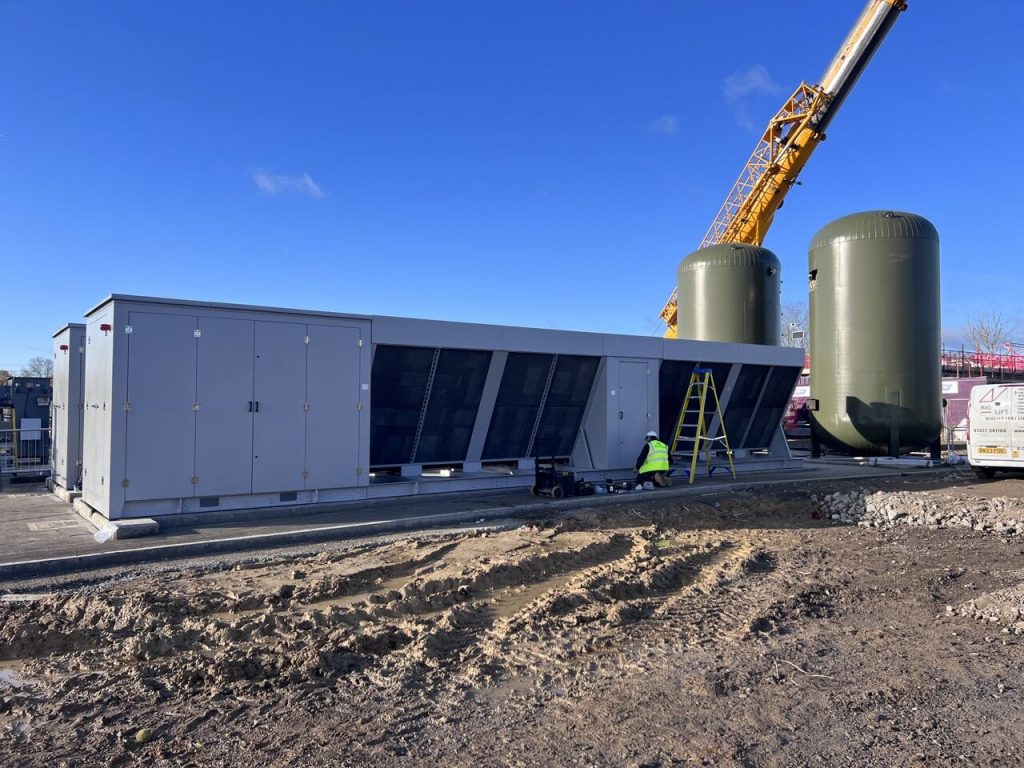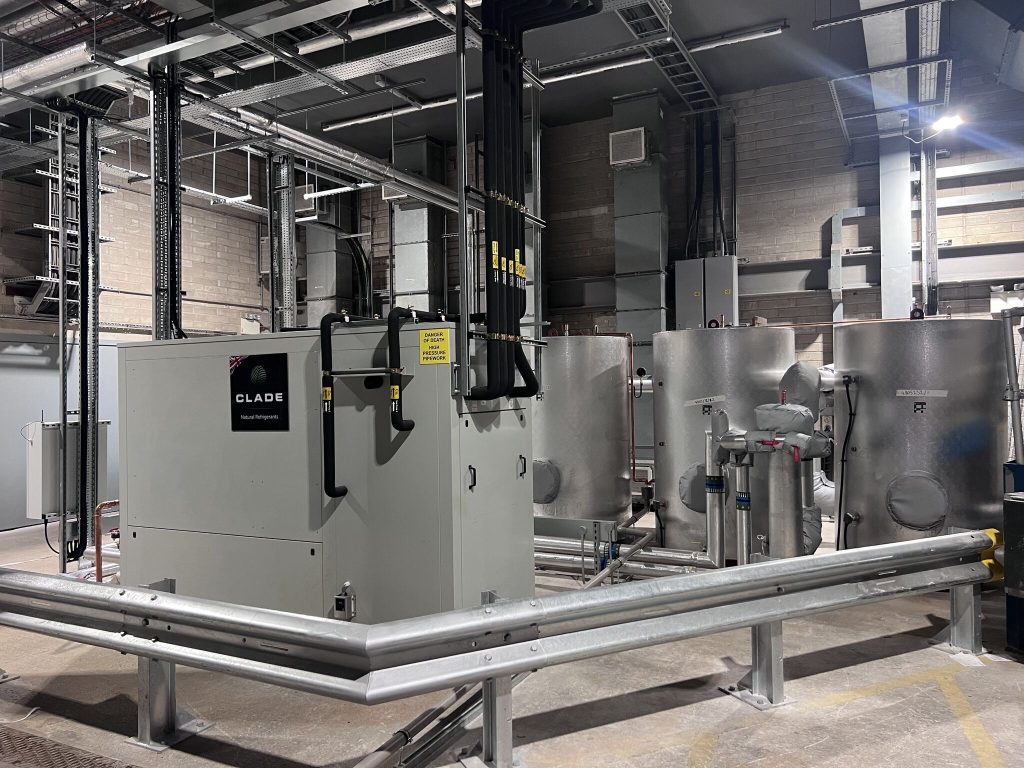Buffer tanks: Expert insights from a Product Technical Engineer

A buffer tank, also known as a buffer vessel, holds heated water so that the heat can be used later.
But what are their main roles? Do heat pump systems need one? And how do you know what size to go for?
Our team of designers and engineers could talk about buffer tanks all day, and we’re proud to be at the front of the curve when it comes to helping our customers to benefit from smaller buffers that can reliably heat your building, even when your heat pump is defrosting.
Here’s the lowdown.
What does a buffer tank do?
Buffer tanks are specific for heat pumps and can play a number of different roles, depending on your system.
- Provide heat whilst your heat pump defrosts
- Optimise the operation of heat pumps
- Add thermal storage
Let’s take a look at each of those roles in more detail.
1. Defrost cycle
When ambient conditions are low, frost will build up on your heat pump’s evaporator coils, which will require defrosting.
Clade uses hot gas defrost to achieve this – meaning hot refrigerant from the heat pump is put through the evaporator.
This is a huge benefit for heat pump owners.
Why?
Well, other heat pump manufacturers use a method called reverse cycle. This involves the heat pump working in reverse and using heat (which is stored in the buffer vessel) to defrost the coils.
The downside to this method is that the heat pump will actually be taking heat away from your building.
Meanwhile, Clade’s method allows heat to still be used by the system rather than pulling from a vessel and preventing heat from reaching the system.
This means that when a buffer is used with our systems, it can be used for heating rather than defrosting.
2. Optimise
Next, a buffer tank can optimise the operation of a heat pump by helping to protect the compressor.
The compressor is at the heart of your heat pump and is essentially its motor. So, it’s in your best interest to ensure it lasts as long as possible.
However, each time your heat pump starts up, this can result in wear and tear on the compressor.
That’s where a buffer comes in!
A buffer tank can store energy so that your compressor only has to start when the buffer gets empty. Then, when your heat pump starts up again, it can work for longer to heat a decent volume of water.
In this way, your buffer can minimise the number of stop-start cycles, resulting in a compressor that lasts longer.
3. Thermal storage
Lastly, a buffer tank can be used as thermal storage.
When a buffer is used in this way, it acts like a battery – you charge heat in advance to be used at peak times.
This means that pre-heated water is ready to be sent straight to your emitters when you need it, which can have a number of benefits:
- Covers the time taken for a heat pump to get to temperature
- Can absorb excess heat during shutdown so there’s no waste
- Opportunity to make use of grid flexibility (using energy at times of the day when it’s cheaper) to reduce your energy bills
The main difference between buffer tanks that are used as thermal storage and those that aren’t is their size – in order to work as a battery, your buffer vessel will need to be bigger.
More on buffer sizing in a bit!
Do heat pumps need a buffer tank?
The simple answer is yes – heat pumps need a buffer (most of the time).
At Clade, we’re one of the only manufacturers of heat pumps that doesn’t require a buffer tank for defrost – unlike most heat pumps on the market, which require a buffer tank with a minimum volume for defrost purposes and wouldn’t be able to operate without a buffer in low ambient temperatures.
However, we would still recommend buffers for our heat pumps in most cases.
This is because, even though our heat pumps don’t require buffers to defrost, a buffer will still help to protect your heat pump’s compressor.
Ultimately though, it’s up to the designer or consultant on each project to decide whether they want to protect their unit as we suggest – meaning a buffer isn’t essential in the same way as it would be for our competitors.
It’s rare, but we have seen projects in the past where a buffer hasn’t been necessary as a heat pump has been designed to run against a constant load – for instance, where our Acer heat pump has fed directly into a swimming pool heat exchanger.
At the end of the day, every project is different!
Why is hot gas defrost better?
As we’ve touched upon already, unlike our competitors, Clade heat pumps don’t require a buffer for defrost purposes.
Instead, we use hot gas as a defrost method.
This is more technically difficult to achieve, but it has several advantages.
No minimum volumes for defrost
Firstly, we don’t have a minimum buffer volume that must be used with our heat pumps in order to thaw the coils.
Instead, the minimum volume needed will be for protecting your heat pump’s compressor – and this volume is usually much lower.
This means that, with a Clade heat pump, you can typically get away with a smaller buffer (depending on your needs and preferences) – saving a significant amount of money and space!
Heat stays in the building
With a Clade heat pump, all the energy that’s being given to the building remains in the building!
This is because we’re not extracting heat from the system to defrost.
On the other hand, most heat pump manufacturers take energy back from the heating system to defrost the coils (in other words, they use the heat that’s been generated previously and is being stored in the buffer tank).
This is inefficient as they’re taking energy back to defrost, then generating heat to put it back in again, then taking it back out, and so on.
Continue receiving heat while your heat pump defrosts
Lastly, with a Clade heat pump, your building can continue to receive heat while your heat pump defrosts – as long as you’re storing enough thermal energy in your buffer to cover those defrost periods.
This is in contrast to other heat pump manufacturers that use the reverse cycle defrost method.
If a manufacturer’s unit uses a buffer for defrost, then they won’t be able to produce any heat for the system to use until the defrost is complete – which, let’s face it, isn’t particularly convenient!
What size buffer tank do I need for a heat pump?
Correctly sizing your buffer is your system designer’s job.
However, they’ll need to take into account the manufacturer’s guidelines, including minimum volume requirements.
At Clade, our minimum volume is the volume of water that allows the compressor to start up safely.
On the other hand, most manufacturers require this, as well as a minimum volume for defrost – meaning their minimum volumes are typically much higher (leading to a bigger buffer that costs more and takes up more space).
That said, there are lots of other factors to consider too. Here are the main ones.
Covering periods of defrost
At Clade, we recommend using around 30 minutes of storage to cover the period when your heat pump is defrosting.
This will allow you to heat your building using your buffer while your heat pump is effectively not in action, for around 30 minutes.
In this way, your building will still be able to meet that peak demand while your heat pump is in defrost – unlike our competitors who use the reverse cycle defrost method and can’t provide heat to your building while your heat pump is defrosting.
Load profile
We also recommend that designers look at the load profile of the building.
This means analysing:
- How much time is spent in peak heat loss?
- How much time is spent in peak demand?
To understand the building load profile, designers can look through your half-hourly gas data, or use thermal modeling.
They can then use this information to size your buffer in a way that will accommodate the peak demand period, as well as the defrost cycles that are going to occur during that time.
Of course, this can look very different for different buildings – while a school might have a two-hour peak demand in the morning, another building might have a peak demand that’s consistent throughout the day for whatever reason.
Energy tariffs
Nighttime electricity tariffs are often cheaper than daytime tariffs.
Oversizing a buffer vessel can give businesses the opportunity to take advantage of cheaper tariffs.
Larger buffer vessels can be charged during the night when energy is cheap, and then this heat can be used later on when your building requires more heat.
Buffer vessels that are used in this way are known as thermal storage.
Refrigerant
The refrigerant that you select will also have a big impact on buffer vessel size.
At Clade, we only use natural refrigerants like propane (R290) and CO2 (R744), as these have low global warming potential (GWP) and won’t release harmful forever chemicals known as PFAS into the environment.
But these refrigerants both require buffers of significantly different sizes.
This is because of what we call Delta T (the difference between the flow and return temperatures produced by the heat pump).
- CO2 has a big Delta T – up to around 40 degrees
- Propane has a much smaller delta T – likely around 10 to 15 degrees
The smaller the Delta T, the larger your buffer vessel will typically need to be.
With that in mind, buffer tanks for propane systems are typically several times larger than those for CO2 systems – making CO2 a great refrigerant choice for those looking to keep their buffer on the smaller side (perhaps due to space constraints). Which brings us onto…
Location
When sizing your buffer, your system designer will also have to think about its intended location, and how much space is available.
Plant rooms are typically standard building heights of around three metres, so this may limit the size of buffer you can select for a project.
However, bear in mind that buffer vessels can be located externally as well as internally – meaning you don’t have to be limited by plant room space.
Just bear in mind that the closer your buffer is located to the air source heat pump, the better.
Number of vessels
It’s also worth noting that you don’t have to settle for just one big buffer vessel.
Rather, the volume needed can be split down into multiple, smaller buffer tanks.
As well as helping to solve space issues, this has the added benefit of reducing the portion of unusable water being stored.
Basically, the water in a buffer vessel is cold at the bottom (where the return water comes in) and hot at the top (where the flow water comes out).
That cold portion of water at the bottom is unusable by the building.
If we take a CO2 system with one buffer as an example, around a third of the water in the buffer will be at around 30 degrees (the return temperature), which can’t be used.
On the other hand, if you have two buffers, this will only apply to around a third of the closest vessel to the heat pump – so, you’re reducing the overall proportion of unusable water.
What specification points are important for buffers?
If you’re using natural refrigerants, the design and specification of a buffer vessel is very important.
This is because natural refrigerants – particularly CO2 – tend to have a wide Delta T.
With that in mind, here are some points that are really important if you’re looking for a buffer vessel for a Clade heat pump.
1. Height to width ratio
In Clade systems, we recommend a tall, skinny buffer vessel – which translates to a height-to-width ratio of at least 2.5 to 1.
This allows the stratification of water (from hot at the top to cold at the bottom) to be maintained, which is important for our control of a heat pump.
If you have a wider, fatter buffer vessel, this can cause those thermal layers to be less defined.
2. Sparge pipes
Sparge pipes are pipes with holes drilled along their lengths, which connect pipes to the buffer vessel.
Using sparge pipes allows us to increase the usable volume of that vessel.
On the other hand, if we were to pipe directly into the vessel, this would decrease the theoretical volume that you’d be able to use – which would affect the sizing.
3. Baffle plates
Another feature we recommend for our heat pump systems is a perforated baffle plate.
This is basically a steel plate with lots of small holes in it, that sits near the bottom of the vessel (around two thirds down).
It acts like a barrier to having high velocities in the vessel, and prevents mixing from the top to the bottom – which is especially important for CO2 systems.
4. Combined flow and return header
At Clade, we also prefer a combined flow and return header in and out of the vessel – as opposed to a one-in-one-out design.
These headers need to be properly sized to prevent the velocity from being too high into the vessel.
We look for no more than 0.3 mps into the vessel to prevent excessive mixing.
5. Temperature sensors
Lastly, buffer vessels should have temperature sensors evenly distributed across the vessel.
This allows the temperature to be properly monitored, to make sure your buffer is working as efficiently as possible.
Installing a buffer vessel: key considerations
Nine times out of 10, your design team will have been to site, scoped it out and decided where your buffer tank will be located long before the installation process.
However, things don’t always go to plan, and there are a number of factors your installation team will need to bear in mind when installing your heat pump and buffer vessel.
Current building and operation
It’s crucial to think about how the installation will affect the current building and operation.
For instance, in a project we recently completed in Coventry, there was already a lot of existing kit externally where we decided to locate our plant area – such as air handlers and access areas.
This all had to be worked around in order to find the best overall solution for the business – not just the team installing the air source heat pump!
Logistics
Another important consideration is how the installation team is actually going to get this huge, heavy piece of metal to its end location.
Depending on where the buffer tank is going to be located, this may involve getting it up or down staircases, onto roofs, or through doors.
This brings us onto…
Safety
When maneuvering a large buffer tank to its final resting place, safety must be a primary concern.
Nine times out of ten, plant rooms are either upstairs on the roof, or downstairs in the basement.
Navigating these obstacles with a one-tonne piece of metal can be dangerous if the right safety precautions aren’t put in place.
Cost
Cost is another factor that can have a big impact on installation decisions.
For one, the more space your buffer tank needs, the higher your overall costs will be – even down to the civil costs of putting the base in.
Plus, if there are complex logistics involved to get your buffer to its end location, this can cause costs to spiral – for instance, it may call for additional specialists or kits.
Maintenance
Your installation team will need to ensure your buffer tank is placed in a position where it’s maintainable.
For instance, heat pumps typically need exclusion zones so that they can be worked on safely.
All tanks have temperature probes, so it’s important that there’s access around the unit so that these probes can be fitted and the vessel monitored on an ongoing basis.
Is it better to locate buffer tanks inside or outside?
Buffer tanks can be located either inside or outside.
From a performance point of view, neither one is better than the other. This is because buffers will be lagged and insulated to take into account where they’ll be located.
In fact, insulation of buffer vessels is so good that, even if you’ve got no demand for the system and it’s a really cold night outside, temperatures in an outdoor vessel aren’t going to drop much at all.
So, given that performance isn’t a factor, should you locate your buffer tank indoors or outdoors?
Well, we tend to see more outdoor installations than indoor, largely because this is often where the space is available. However, there’s no one ‘right’ answer, and it will all depend on the unique needs of your business.
Here are a few pros and cons of each.
Pros of outside
- Logistically easier. There’ll be no need to get your buffer tank up and down staircases or through doors.
- More space. Often, there’s more space available outside than inside.
- Height isn’t an issue. You won’t have to worry about ceiling height when installing a tall buffer vessel.
Cons of outside
- Planning. Locating your buffer vessel outside may mean taking up car parking spaces or even removing trees – this could lead to issues with the council or the need for planning permission.
- More heat trace. The further the pipe runs to the buffer vessel, the more heat trace is needed. Heat trace is a bit like cable wrapped around the pipes to stop them from freezing when ambient temperatures are very low.
- Security. Locating your buffer outside could leave it more vulnerable to vandalism – but fences and enclosures are available to help.
Pros of inside
- Slightly cheaper. Buffers located indoors don’t need as much insulation, and they won’t need protection for weatherproofing.
Cons of inside
- Safety. Getting a buffer vessel into a building – especially onto the roof or into a basement – can have health and safety implications.
- Logistically complex. Getting a buffer up and down staircases, over roofs, or through doors can necessitate specialist people and kits – which can cause costs to spiral.
Buffers and the Construction (Design and Management) Regulations (CDM)
CDM refers to the main regulations for managing health, safety, and welfare on construction projects in the UK.
These regulations mean that heat pump system designers don’t just need to design a system that can be installed safely.
They also have to make sure the system can be maintained safely in the long run.
After all, the units have to be properly maintained to get potentially 15-20 years of life out of them, so it’s important to think about the practicalities and how to do this safely from the outset.
Here are a few important examples and considerations when it comes to heat pump systems.
Safe charging
Imagine a heat pump that’s installed 20 stories up, on the roof of a high-rise block of flats.
An important consideration from the outset should be how that system will be safely charged.
Ordinarily, this would require having workers carry up to 600 or 700 kilos of gas to the roof in 20-kilo bottles – which would require a lot of trips!
A smarter option could be to charge the units using charging lines. This is essentially pipework that could run from the roof to the ground floor through the building internally, to charge the units more easily.
Minimum clearance
At Clade, we always specify a minimum clearance for our units in order to allow engineers to work safely.
The minimum clearance around any Clade unit is 800mm along the evaporator and 1.2m in front of any doors for access.
Likewise, if working in an electrical panel, there needs to be a minimum of a meter space.
This is because, if someone gets an electric shock and that space is less than a metre, there is a risk that the operative could bounce backward into what’s behind them, and then be flung back to where they received the electric shock – potentially getting trapped.
Safety vent valves
A very common CDM issue with buffer vessels is placing the safety valve on top of the vessel.
This can then make the vessel unmaintainable because the valve is out of reach.
Let’s talk about buffers
As you can see, there are so many nuances and considerations that need to be accounted for when designing a heat pump system that includes a buffer (or several).
But you shouldn’t have to worry about any of that.
Rather, it’s your system designer’s responsibility to make the best decisions for your building and heat pump system – taking into account all the information available from the building, its dynamics, and the recommendations of the heat pump manufacturer.
At Clade, we’re proud to be at the front of the curve when it comes to heat pump technology – offering heat pumps that use the hot gas defrost method so that our customers can benefit from smaller (and therefore cheaper!) buffers, and reliable heating even when your heat pump is defrosting.
To find out more about why a Clade heat pump is the best option for your business – or to get our designers’ help creating a system design that matches your needs perfectly – simply get in touch!






